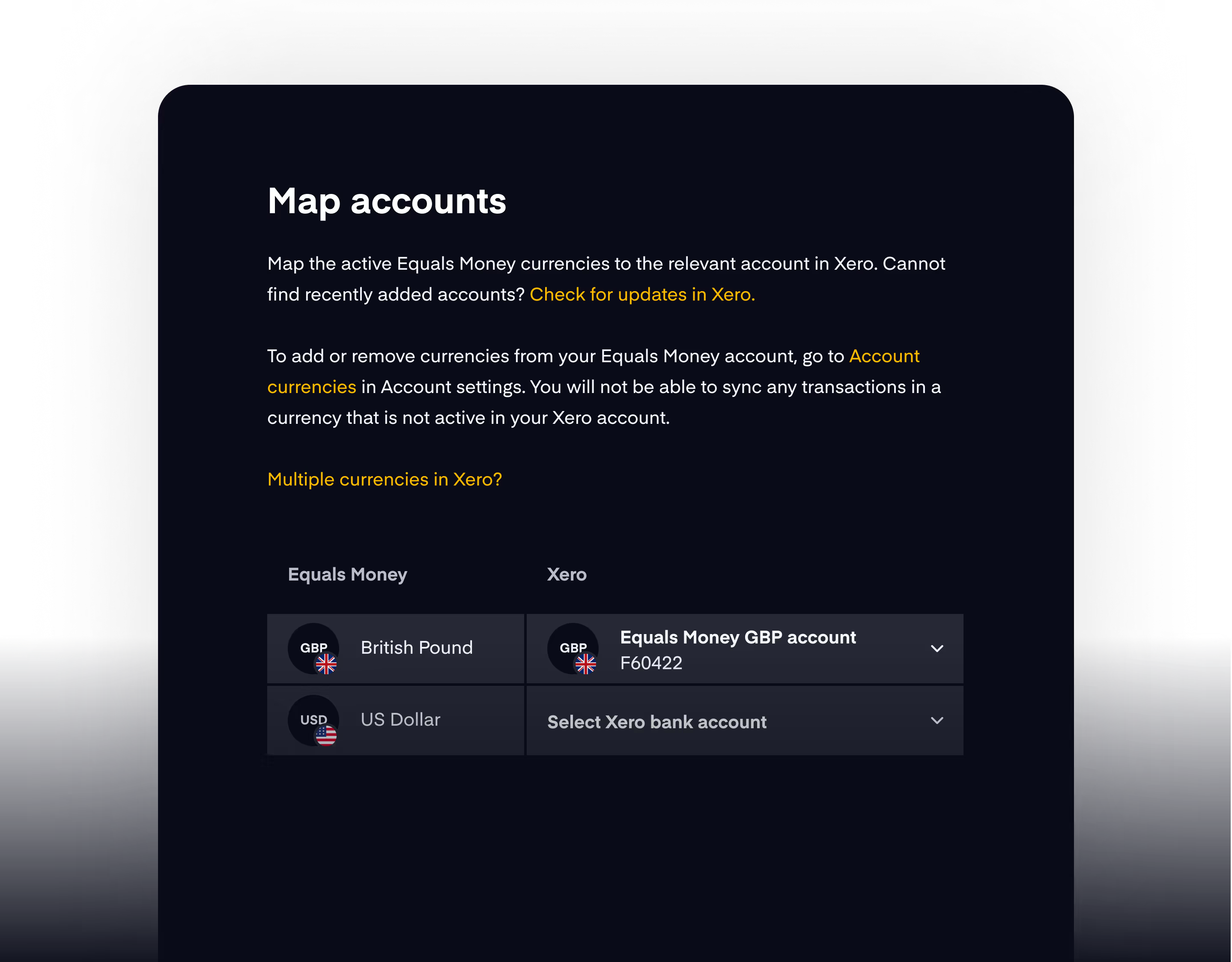CHF
The Swiss franc (CHF) is widely recognised as one of the world’s major currencies and a cornerstone of global finance. Despite Switzerland’s relatively small size, the CHF plays an outsized role in international markets thanks to the country's economic stability, strong banking sector, and long-standing political neutrality.
Often regarded as a “safe haven currency", the Swiss franc is a preferred choice for investors during periods of global uncertainty. It is also one of the most actively traded currencies in the FX market, frequently paired with the US dollar, euro, and other leading currencies.
With its reputation for reliability, low inflation, and strong central bank governance, CHF continues to be a trusted store of value and a key player in global monetary policy, financial services, and FX trading strategies.
Yes, you can make purchases in CHF using an Equals Money card.
Equals Money cards support 21 global currencies (including CHF), allowing you to make local currency purchases in Switzerland. However, your card balance must include the required amount in CHF.

This is an answer heading
This is an answer body
.png)
Yes, you can receive payments in CHF using an Equals Money account.
Equals Money accounts are equipped with a multi-currency IBAN, allowing you to receive payments and manage funds in 38 global currencies (including CHF), without the need for currency conversion.

Yes, you can make payments in CHF using an Equals Money account.
Equals Money allows outbound wire payments in 61 global currencies (including CHF). Read more on how to make an online payment here.
If you're an existing payments customer and do not have access to an online account, please speak to your account manager or get in touch with our team.

Yes, you can make bulk payments in CHF using an Equals Money account.
Equals Money allows bulk (batch) payments in 35 global currencies (including CHF).

Historical context of Swiss franc
The Swiss franc has its origins in Switzerland's economic consolidation during the 19th century.
Prior to 1850, over 800 different coins circulated across Swiss cantons, creating a fragmented and inefficient monetary system. To unify the currency landscape, the federal government introduced a foundational piece of legislation known as the Federal Coinage Act, which established the Swiss franc as the official national currency of Switzerland.
Later in 1865, Switzerland joined the Latin Monetary Union, along with France, Belgium, and Italy. The Coinage Act had already prepared Switzerland for this by aligning its coinage standards with those of France, as the Swiss franc was based on the French franc in weight and value. In addition, the Federal Coinage Act also laid the legal groundwork for the creation of Swissmint (the Swiss federal body responsible for coin production), and paved the way for the Swiss National Bank, which was later established in 1907 to handle monetary policy and banknote issuance.
Over time, as other nations left the Latin Monetary Union, Switzerland retained and strengthened its independent currency system.
Throughout the 20th century, CHF became increasingly associated with economic stability, particularly during periods of global financial crisis and turmoil, such as the World Wars, the Great Depression, and the 2008 global financial crisis. Investors and central banks began to view the Swiss franc as a “safe haven currency” due to Switzerland’s long-standing neutrality, low inflation, strong fiscal discipline, and highly developed financial sector.
The franc maintained its independence even after Switzerland chose not to join the European Union or adopt the euro, reinforcing its role as a symbol of national sovereignty and economic resilience.
Currency symbol
The symbol most commonly associated with the CHF currency is Fr., often appearing before or after the amount, depending on the language or regional context (e.g., Fr.100 or 100 Fr.).
In multilingual Switzerland, the currency symbol adapts slightly to fit various linguistic customs, sometimes written as SFr. or CHFr. in official documentation. However, when used in financial systems, cross-border payments, or international money transfers, the ISO currency code CHF is the preferred shorthand.
This diversity of usage reflects Switzerland's unique cultural makeup, but the functionality remains consistent. Unlike the US dollar ($) or euro (€), the Swiss franc’s symbol is not globally stylised but retains clarity and neutrality—echoing Switzerland’s own political stance.
The consistent use of CHF in international markets ensures that the CHF currency is instantly recognisable and avoids confusion with other franc-denominated currencies such as the Central African CFA franc or the West African CFA franc.
ISO code
The Swiss franc is internationally designated by the ISO currency code CHF, which stands for Confoederatio Helvetica Franc.
“Confoederatio Helvetica” is Latin for the Swiss Confederation and is used to avoid favouring any one of Switzerland’s four official languages (German, French, Italian, Romansh). This standardisation ensures global consistency in financial systems, databases, trading platforms, and currency markets or exchange services.
The CHF code is essential for international business, forex trading, and banking operations. It appears in SWIFT codes, foreign exchange market conversions, and global trade documentation. The currency’s ISO classification contributes to its reliability, as institutions and investors recognise it as one of the most stable and secure fiat currencies in the world.
Central bank
The Swiss National Bank (SNB) is the Swiss central bank and central authority responsible for issuing and managing the Swiss franc.
Established in 1907, the SNB operates independently from political influence, with a constitutional mandate to ensure price stability while supporting the Swiss economy. It regulates monetary policy, decides interest rates, manages the country’s gold and foreign currency reserves, and oversees the production of CHF banknotes.
One of the SNB’s most notable interventions occurred in 2011 when it set a minimum exchange rate of 1.20 CHF per euro to curb excessive appreciation and protect the export-driven Swiss economy. However, this policy was abandoned in 2015, triggering sharp movements in the forex markets and reinforcing the notion of CHF as highly sensitive to central bank policy shifts.
The SNB’s commitment to transparency, low inflation, and conservative policy measures continues to underpin the strength and trustworthiness of the CHF globally.
Read more about the Swiss National Bank's interest rate decisions here - When is the next SNB interest rate decision?
Denominations
The Swiss franc is issued in a broad range of denominations that cater to both everyday transactions and larger-scale financial needs.
Swiss banknotes come in six denominations: 10, 20, 50, 100, 200, and 1,000 francs, with the 1,000-franc note being one of the highest-value banknotes in global circulation. These notes feature advanced security features (security features include color-shifting elements, watermarks, microtext, security threads, UV features, raised print, transparent windows, and holograms to ensure maximum protection against counterfeiting), innovative designs, and themes that reflect Switzerland’s culture, science, and values.
Currency subunit
CHF is divided into 100 smaller units known as centimes in French, Rappen in German, centesimi in Italian, and rap in Romansh.
These subunits are essential for pricing accuracy in retail and commerce, especially in Switzerland where high living standards and consumer prices require detailed currency denominations.
Swiss coins are issued in denominations of 5, 10, 20, and 50 centimes, as well as 1, 2, and 5 francs. The coins are widely used and are known for their durability and precision minting. As mentioned, all Swiss banknotes are issued by the Swiss National Bank, while Swiss coinage is produced by Swiss mint (Switzerland’s official minting and Swiss coinage authority), ensuring high quality and strong resistance to counterfeiting.
Though low-value Swiss coins such as the 1 centime have been discontinued due to lack of use, others like the 5, 10, and 20 centime coins remain vital for cash transactions. Switzerland’s precise rounding system ensures that even with minor coin usage, customers receive fair and consistent pricing.
Official name and common nicknames
The official name of the CHF currency is the Swiss franc, though it is known locally by different names depending on the language: Franken (German), franc suisse (French), franco svizzero (Italian), and franc svizzer (Romansh). Despite the linguistic variation, the meaning and value remain standard across all Swiss regions.
In forex markets and among traders, the Swiss franc is commonly nicknamed the “Swissie.” This informal name is widely used in trading desks, financial media, and economic commentary.
Common CHF forex trading pairs
CHF is one of the most frequently traded currencies in the world, despite Switzerland’s relatively small population. Its perceived safety, liquidity, and stability make it a favourite in global foreign exchange (forex) markets and financial services. Some of the most traded CHF pairs include:
- USD/CHF (US dollar/Swiss franc) – A key barometer for global risk sentiment, with the franc often appreciating during geopolitical crises.
- EUR/CHF (euro/Swiss franc) – A closely monitored pair due to Switzerland’s deep economic ties with the eurozone.
- GBP/CHF (British pound sterling/Swiss franc) – Popular among traders seeking volatility around UK or Swiss economic releases.
- CHF/JPY (Swiss franc/Japanese yen) – A pair combining two safe-haven currencies, often used to hedge against macroeconomic uncertainty.
- AUD/CHF (Australian dollar/Swiss franc) – Used to express views on global growth (AUD) versus stability (CHF).
These pairs are actively traded by institutional investors, hedge funds, and retail forex traders. CHF benefits from narrow bid-ask spreads, low transaction costs, and high liquidity, especially during European trading hours.
Is CHF a reserve currency?
Yes — CHF (Swiss franc) is considered a reserve currency, but on a smaller scale compared to the world’s dominant reserve currencies like the US dollar (USD), euro (EUR), Japanese yen (JPY), and British pound sterling (GBP).
















